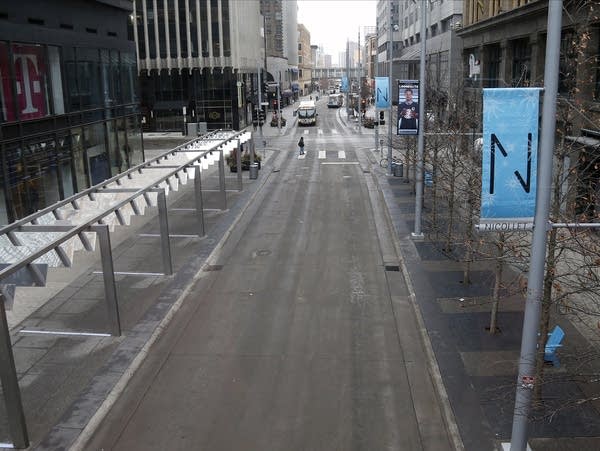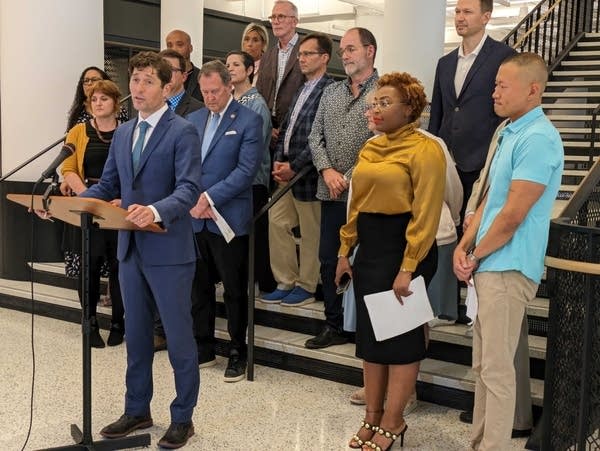What should a post-2020 downtown Minneapolis look like?

Raising his voice to be heard over the rumble of nearby buses on Nicollet Avenue, Minneapolis Mayor Jacob Frey described his vision for the city’s downtown, which was hit hard by the pandemic and unrest after George Floyd’s 2020 murder by a Minneapolis police officer.
The mayor pointed to a large vacant storefront: “That model doesn’t work anymore,” he said, “rather than being one gigantic 10,000 square foot shop, why not five 2,000 square foot shops?”
Like many across the country, Minneapolis’ downtown, which was geared toward retail and office space, has struggled as employees embraced remote work.
“Downtowns around the country and in fact around the world have been changed forever, and we’re going to have to change with it,” Frey said at a press conference Tuesday.
Create a More Connected Minnesota
MPR News is your trusted resource for the news you need. With your support, MPR News brings accessible, courageous journalism and authentic conversation to everyone - free of paywalls and barriers. Your gift makes a difference.
Frey suggested one solution might be to remove motorized traffic from Nicollet Avenue in downtown and painted a picture of a pedestrian mall that includes dining or even a playground. Although Frey admitted that lots of details need to be worked out before that can become reality, he said he’s hoping to try some temporary closures of blocks this summer to test it.
It was among the recommendations made by a working group formed by the mayor late last year in a report issued Tuesday. They also outlined other ways to draw people back to downtown, including loosening liquor laws to allow open containers outside during events.

“What became immediately apparent is that the answer to the question of how to create a more vibrant downtown retail scene was not limited to retail itself,” Frey said. “It’s going to include how our downtown workforce operates, how we transition from office space to residential, it will be having a more organic approach, and a more flexible approach with how we zone, how we regulate and how we authorize storefront use on Nicollet Mall and beyond.”
Frey said the occupancy rate downtown is between 65-70 percent, but that they’d like to get it up to 80 percent or better. He said during the press conference that the city needs to explore how to transition some spaces to residential uses, including perhaps single occupancy housing that’s more affordable.
The group also recommended hiring someone who can connect building owners with potential businesses and even artists who can utilize spaces that were traditionally offices or large retail. They also want the city to adopt practices that incentivize building owners to fill their spaces at lower rents than they received before the pandemic and to reassess land use regulations and licensing to make it easier on businesses.
The group’s co-chair Gabrielle Grier, CIO of the African American Leadership Forum, said in a statement that she’s optimistic about equitably enacting the group’s recommendations.

“I will be pushing to ensure inclusion for Black and folks of color, artists, designers, and business owners, developers, and entrepreneurs as the reinvigoration of our downtown takes place,” Grier said. “My hope is that people of all cultures will be attracted to our downtown area, finding that downtown Minneapolis holds something for everyone.”
Council Member Michael Rainville, who served on the advisory group, vowed that elected officials will play a role in revitalizing the area.
“Downtown Minneapolis is not only the economic engine of the Third Ward, it’s the economic engine of Minneapolis, of the state of Minnesota and really the Upper Midwest region. That is where the tax dollars are created and that is where the jobs are created,” Rainville said. “It is so important to bring downtown back, and we are doing that.”
The advisory group recommended that the mayor invest $75,000 this year that will be matched by the Minneapolis Downtown Council, along with an additional $750,000 next year. Frey said some of the group’s recommendations will likely show up in his budget later this summer.